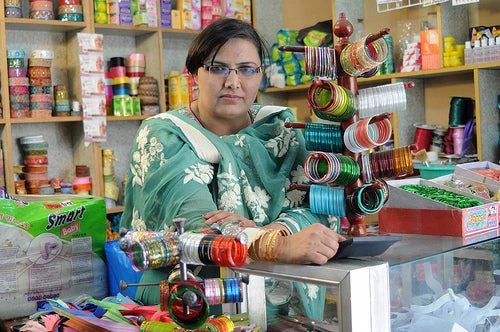
To really understand what the underlying challenges were in reaching women, especially women microentrepreneurs, we went deep into gathering information from MFI clients, women who could be clients but were opting out, loan officers, field level managers, head office, and other stakeholders, such as business service providers. Very soon into the process a few clear patterns emerged, which were consistent across the range of respondents and participants in the study – and these patterns were rather striking.
First, it became very clear, and seems to be the worst kept secret in Pakistan, that most of the loans for women clients are actually being used by a male family member – a brother, a son, a husband, a father. Actual numbers are hard to pin down, but estimates range between 50 and 70 % of the loans on the books for women clients are solely used by another household member, while the woman ‘borrower’ is responsible for attending all the group meetings, all repayments, all the stress, and all the transactions costs. Not one stakeholder we interviewed, from the highest CEO to the lowest loan officer, found these figures surprising or hard to believe. For all of our talk about microfinance as a way to empower women, it seems that we may inadvertently be doing the opposite.
But what about the real women clients – the ones who are self-employed, or run an enterprise, or have a great idea to start a business? Is there still space for them to engage, to borrow, and to build their livelihood? Many common practices among MFIs are actually preventing or discouraging these potential entrepreneurs or income generators from using microfinance for start-up, cash-flow, or growth. Many group loan products are simply too small or time consuming to make them worthwhile for these clients. Yet larger, individual loans are out of reach – rarely are they offered to women, and if they are the requirements usually act as severe deterrents. Requiring 2 male guarantors, who are not family members can be a deal-breaker for these women. Yet, a woman guarantor is not accepted in any lending institution in Pakistan at the moment. Almost all women borrowers are required to have the permission of their husband to access a loan, even in group lending schemes. And young, unmarried women are not considered credit worthy by these institutions.
Why? Because of the prospect of a future marriage somewhere down the line. Loan officers freely admit that they don’t market larger business loans to women, and many current clients or female loan officers aren’t even aware of more business-friendly products that are usually offered exclusively to male clienteles.
All of these findings could point to a sector which has set aside the needs of women. Yet most stakeholders hold a real and genuine commitment to supporting women in Pakistan. So the situation is not as simple as it seems, and the answers and prescriptions are not that straightforward. Why are men often using the women in the household to borrower? Because there simply is not enough credit to go around, and the need for resources for these men is both genuine and urgent. Why do loan officers and management approve loans even when they know about the passing-on of loans to men, and that often women aren’t the final borrowers? Because of the drive to achieve gender targets and demonstrate outreach. Why are women always asked to have their husband’s consent to borrow? Because many businesses are family enterprises, and almost everyone who knows Pakistan thinks that a woman’s business will never survive unless she really does have the support of her husband.
So, while there is scope for some very simple stroke-of-the pen changes that can be implemented by MFIs (e.g. allowing young unmarried women to be borrowers, encouraging loan officers to reach out to women entrepreneurs with more business friendly loan products), many other issues are more complex, and will require a very Pakistani-developed solution. Should we be re-thinking gender targets together, since they have very negative and unintended consequences? What is the role of the husband and wife in running a business, and where does it transform from a partnership to a subordinate role? What are the other services that we need to offer women borrowers so that they can go beyond small consumption into income generation?
Are these issues unique to Pakistan? We don’t think so, and it might now be worth looking again to Pakistan as a role model to watch how they tackle and address these fundamental challenges.


Join the Conversation